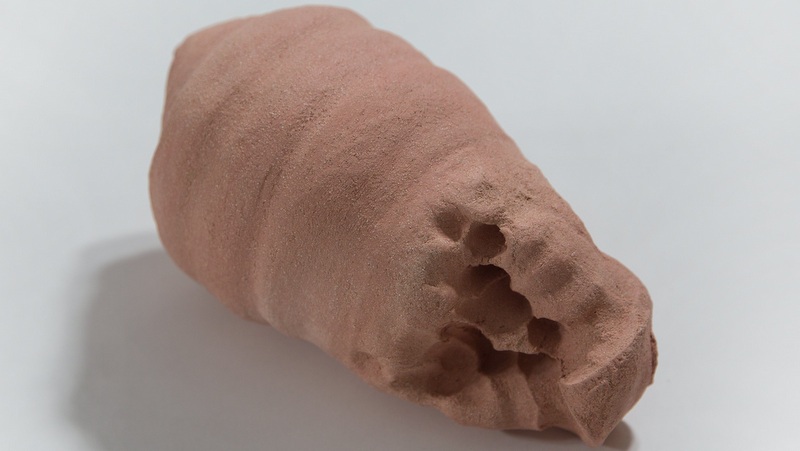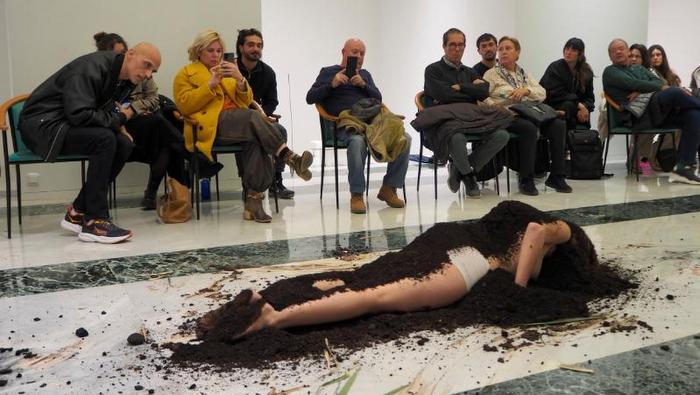Ceramic exhibition that puts this material in dialogue with sculpture, installation and video, exploring the language of the hands in a series of actions that involve doing, gesture and handtprint. Ceramics question domestic policy dynamics, such as the dialogue between the hard and the malleable; the left and the right; the organic and the artificial; the symmetry and the default. They are a set of gestures enunciations mixed with daily residues. As ironic comments to the landscape made with the hands.
WHEN THE LANDSCAPE IS THE SKIN
Sergio Alvarez
The mechanisms that sustain life hate to be exhibited—they usually hide under a layer of beauty or an accumulation of accidents that, as appropriate, we call landscape or skin. It is to this aesthetic cover-up that Natalia Castañeda Arbeláez has dedicated her artistic inquiry.
From the first exhibitions, the reflection on the landscape, its methods and its forms crosses the work. There are paintings that turn color into an inquisitive look at nature, there are installations that invite us to interact with their fragility, there are sculptures that lead us to ask ourselves about what we are seeing and the need to represent it. There are rivers that flow as a form of vital optimism and there are videos that turn mountain observation into a meditation in which beauty and doubts strike like wind in the face.
Natalia's work observes with attention the aesthetic passion of the planet and forces us to ask ourselves why it exists. In Caricias y Pellizcos, Natalia takes a break from walking and travelling, and locks herself in the workshop to work the clay, a material that is also hidden beneath the surface of the world we live in but that once discovered has given man a home, daily tools and possibilities of self-representation.
Clay is perhaps the most primitive artistic material and is therefore a material to which oneself must devote without prejudice or bias. In the hands of Natalia, ceramics become at the same time stone, body or industrial landscape and its flexibility or hardness are sculpted as fetish, scrap or skin. In medium sized sculptures she opposes what is industrial to what is sensual, what the machine has built and what has been the result of the desire of the biological to reproduce. They are pieces that contrast what is residual with what is ephemeral, figures in which the hand does not try to give shape but to follow the trail of a world that rises thanks to the need for love, caprice or despair.
Smaller and therefore more intimate pieces are exhibited alongside them. Small sculptures that caress the mud, press it, massage it, pinch it, rub it and, as in human relationships, are the product of such love and complicity that leave traces impossible to erase. This set of ceramics turns into stone what was once delivery and, with it, leads us to ask ourselves why life is an eternal will and an eternal risk at the same time.
The third component of the exhibition is a video in which the reflection on the living and its representation is a dialogue between a restless arm and hand and their mud doubles. What is initially a tribute becomes a conversation, a game of opposite and complementary, of left and right, of forces that release or grasp. A talk that has a moment in the sun and that slowly loses its playfulness and joy and becomes complaint and violence.
Are love and desire a form of prime or just the beginning of decadence? Are caressing, kissing, or pinching faces of happiness or signs of a future sadness? Why does the malleable pass through fire and become stone? Why is desire also a way of self-destruction?
Natalia turns ultimately the mud into the materialization of time, showing how each passing day destroys even the most beautiful landscape or the most beautiful skin. Skin and landscape are at the same time the maximum expression of beauty and the cover of a living mechanism that is exhausted, that dies, a mechanism that breaks down, whether we like it or not.
Opening Friday, April 20th 2018, 20 h.
April 20th - June 9th 2018
Isabel Hurley Gallery















